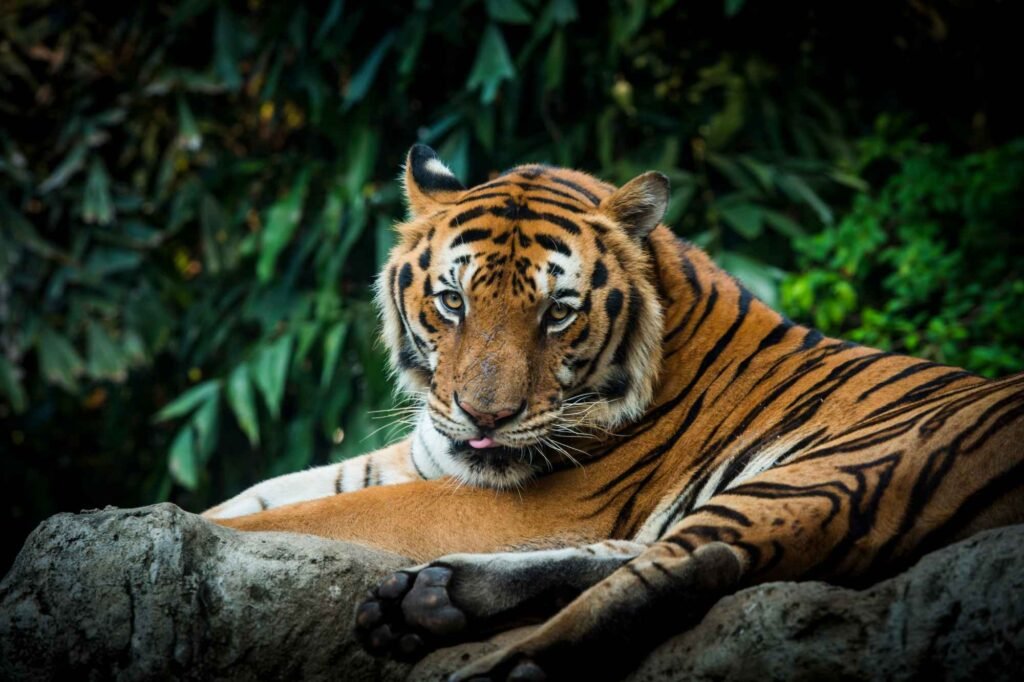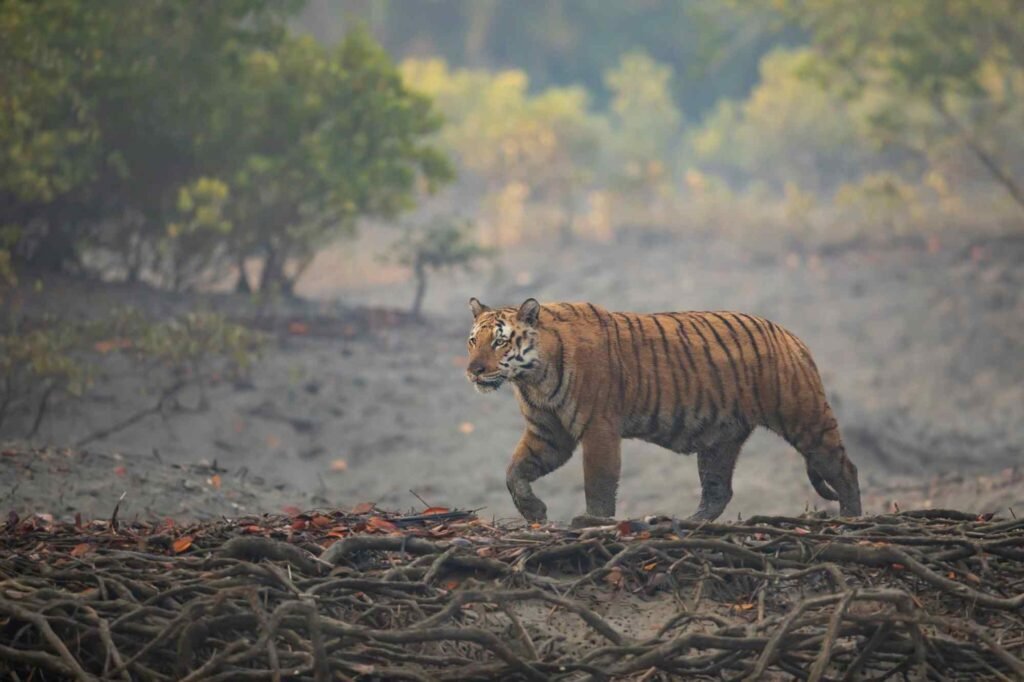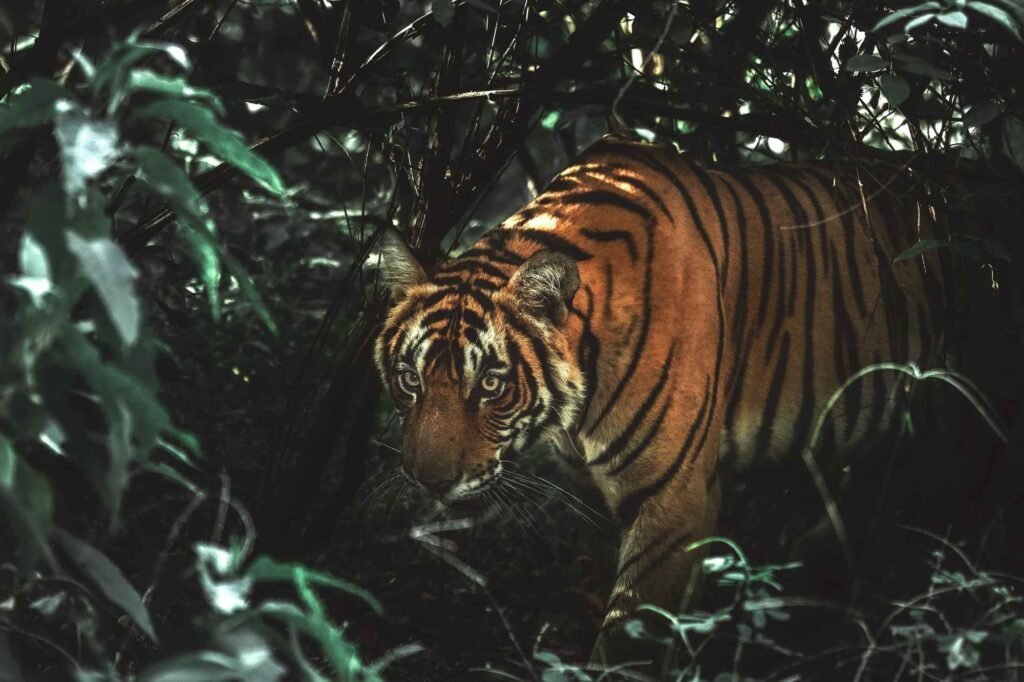Royal Bengal Tiger in Sundarbans
sundarbanmondaltravels.com
June 19, 2025
Introduction – Why This Guide Matters
The Royal Bengal Tiger of the Sundarbans is one of the most powerful and mysterious animals on Earth. People often ask: Are these tigers really man-eaters? Can we spot one on a tour? How do they survive in the muddy mangrove forests? This blog answers all those questions—and more.
Our goal is simple: to create the most complete, easy-to-read, and fact-based guide about these incredible animals. Whether you’re a tourist planning a trip, a student doing research, or simply someone curious about tigers, you’ll find everything you need here.
We go beyond myths and news headlines to give you real data, local knowledge, behavior insights, and wildlife facts. This guide is written by Sundarban tour experts at Sundarban Mondal Travels, who’ve seen the land and heard the stories firsthand.
Let’s explore the world of Sundarban’s tigers—raw, wild, and real.
Scientific Identity & Classification
| Category | Details |
|---|---|
| Common Name | Royal Bengal Tiger |
| Scientific Name | Panthera tigris tigris |
| Kingdom | Animalia (Animals) |
| Phylum | Chordata (Has backbone) |
| Class | Mammalia (Warm-blooded, gives birth) |
| Order | Carnivora (Meat-eaters) |
| Family | Felidae (Big cats & domestic cats) |
| Genus | Panthera (Lions, tigers, leopards) |
| Subspecies | Panthera tigris tigris (Bengal tiger) |
Explained Simply
The Royal Bengal Tiger is a large wild cat that belongs to the same family as lions and leopards. It’s warm-blooded, has sharp teeth for hunting, and is known for its orange coat with bold black stripes. This tiger is unique to the Sundarbans mangrove forest, where it has evolved to swim, survive in salty water, and hunt in dense mud-covered areas. Among all tigers, this one is a symbol of power, survival, and mystery in the wild.
Physical Appearance & Unique Traits
The Royal Bengal Tiger found in Sundarbans has a leaner and more agile build compared to its cousins living in dry forests or grasslands. Its body is built for movement through dense mangrove roots and muddy terrain. The coat is orange to light yellow, marked with dark brown or black stripes. The underbelly and inner legs are white, and the tail is orange with black rings—perfect for camouflage in dappled forest light.
Key Physical Features:
Males weigh up to 220 kg (485 lbs) and measure around 3.2 meters (10.5 ft).
Females are smaller, averaging 135 kg in weight. sources…
Their muscles and limbs are strong, aiding in long-distance swimming—up to 5 km at a stretch.
Unique Adaptations:
Tolerant to salty water
Excellent swimmers
Smaller but stronger frame
Adapted to wet, muddy, and shifting terrain
These traits help them survive and rule the challenging Sundarban ecosystem.
The Mangrove Kingdom – Sundarbans Habitat
The Sundarbans is the world’s largest mangrove forest, located in the delta region of the Ganges, Brahmaputra, and Meghna rivers, spanning parts of India and Bangladesh. It’s not just a forest—it’s a maze of muddy islands, tidal rivers, creeks, and saltwater swamps, constantly reshaped by monsoon rains and rising tides.
For any animal, survival here is a challenge. But for the Royal Bengal Tiger, it’s home.
A Challenging Terrain:
The land is often waterlogged and unstable.
High salinity levels affect plants and animals.
Prey is scattered, and thick mangrove roots make running or chasing nearly impossible.
How Tigers Adapt:
Strong swimmers: They cross wide rivers between islands.
Salt-tolerance: Their kidneys handle the Sea saltwater.
Lean bodies and large paws: Help move through mud and swamps quietly.
Excellent memory and stealth: Crucial in a terrain with no clear paths.
This dynamic environment has shaped the Sundarbans tiger into a unique and resilient predator, capable of living in one of the most unpredictable and amphibious habitats on Earth.
Survival Superpowers – Adaptations of the Royal Bengal Tiger
The Royal Bengal Tiger of the Sundarbans isn’t just any tiger. To survive in this water-dominated, muddy, and unpredictable landscape, it has developed extraordinary physical and behavioral adaptations—true superpowers of nature.
Expert Swimming
Unlike most big cats, Sundarbans tigers can swim for several kilometers across wide tidal rivers and creeks. This skill is essential in a landscape broken into hundreds of water channels.
Camouflage Master
The tiger’s orange coat with black stripes blends perfectly with sunlit mangroves, tall grasses, and muddy terrain. This helps it ambush prey silently, even in open daylight.
Saltwater Tolerance
Sundarbans tigers survive by drinking rainwater collected in tree hollows and tolerate brackish water environments better than other tiger subspecies.
Lean, Agile Structure
Their smaller, leaner bodies and wide paws allow them to move quietly through mud, dense roots, and shrubs where larger tigers would struggle.
Behavior & Hunting Pattern
The Royal Bengal Tigers of Sundarbans are solitary and stealthy ambush predators. They live and hunt alone, marking their territories with urine sprays, claw marks on trees, and roars to warn intruders.
Unlike tigers in other regions, Sundarbans tigers are flexible in their activity patterns. While many are active during early morning or twilight, they also hunt during the day or night depending on tides and prey movement. This adaptability helps them survive in a constantly changing mangrove ecosystem.
Their hunting strategy is all about silence and surprise. Tigers patiently stalk their prey, using the dense cover of mangroves, then leap with deadly speed and power. A single swift bite to the neck or spine usually ends the hunt.
These tigers hunt chital deer, wild boars, monkeys, and even fish or crabs when larger prey is scarce. Their unpredictable pattern makes them both fascinating and feared.
Human‑Tiger Conflict – Why It Happens
In the Sundarbans, human‑tiger conflict isn’t rare—it’s part of life for many forest‑dependent communities. Poverty drives villagers to fish, gather honey, or collect wood, often in restricted core zones. These essential activities bring them face‑to‑face with tigers.
Historically, 20–60 attacks occurred annually; today the number is 20–40 reported cases, though many go unrecorded. In 2014, about 36 people died each year on the Indian side alone. Between 2008–2022, NGOs recorded 275 human attacks and 349 livestock losses.
Real-world cases:
- A forest worker was attacked in Nagenabad while installing nylon fences in February 2025
- Another incident involved villagers’ rescue teams being mauled while chasing a tiger from Maipith
Why does this happen? Tigers sometimes enter villages due to shrinking habitat, broken fencing, or during high tide. They are solitary ambush predators, so unexpected encounters often lead to human injuries.
Impact:
Beyond fatalities, victims’ families face emotional and financial hardships. Known as “tiger widows,” many suffer stigma and poverty after losing their breadwinner .
Spotting Tigers – Where & When?
Seeing a Royal Bengal Tiger in the Sundarbans is a once-in-a-lifetime moment—if you’re lucky. These elusive predators are masters of stealth, thriving in the dense mangrove thickets and muddy creeks. Unlike national parks with open grasslands, the Sundarbans’ tangled forests and shifting tides make tiger sightings extremely rare, especially for tourists.
Still, there are some known hotspots:
Sajnekhali Watch Tower – A hub for tourism, also houses the forest office.
Sudhanyakhali – A popular tower surrounded by creeks and open clearings.
Pirkhali, Jharkhali, Chilmari Creek, Panchamukhani – These areas have seen relatively frequent tiger activity, especially early mornings.
Best time to try your luck?
The dry winter months (October to March) offer the best visibility. Crocodiles and deer bask in the sun along the riverbanks, and tigers often follow prey here. December and January are especially known for peak activity.
However, it’s important to set realistic expectations. Tiger sightings in the Sundarbans occur in less than 1% of tours. Most tourists enjoy the thrill of tracking pugmarks (tiger footprints), listening to guide alerts, and scanning creek edges.
The experience is less about seeing a tiger—and more about sensing its powerful presence in the wild.
Myths & Folk Beliefs – Bonbibi and Dakshin Rai
In the Sundarbans, the Royal Bengal Tiger is not just a wild animal—it is a spirit of the forest. Locals believe in Bonbibi, the goddess who protects honest forest dwellers, and Dakshin Rai, the tiger demon who tests human greed. Every honey collector or woodcutter entering the jungle prays to Bonbibi for safety and forgiveness, carrying her idol or chanting her name.
The stories tell of Bonbibi defeating Dakshin Rai not by violence, but through fairness and mercy, symbolizing balance between man and nature. Yet fear remains deep-rooted—tigers are both sacred and deadly.
This spiritual duality shapes daily life. Tigers are called “Boro Ma” (Big Mother) with reverence, but villagers still mourn the regular loss of loved ones.
These legends are not superstition—they are a way of coping with fear, respecting nature, and passing on survival wisdom across generations.
Conservation & Protection Efforts
The Royal Bengal Tiger of the Sundarbans is classified as Endangered on the IUCN Red List, making conservation efforts absolutely critical. Over the years, both India and Bangladesh have taken strong steps to protect these majestic cats and their fragile mangrove habitat.
Government Initiatives
India launched Project Tiger in 1973 to conserve tigers across the country, and the Sundarban Tiger Reserve was established soon after. In Bangladesh, similar efforts are guided by the Forest Department and Wildlife Conservation Act. Special laws are in place to punish poaching and habitat destruction.
Sajnekhali’s Crucial Role
The Sajnekhali Tiger Reserve in West Bengal acts as a central hub for conservation. It’s a safe zone for researchers, tourists, and forest officials alike. With watchtowers, rescue centers, and education programs, it promotes both awareness and action.
NGO and Community Involvement
NGOs like WWF, Wildlife Trust of India, and Save the Tiger Fund work with local communities to create alternative livelihoods, reducing dependence on risky forest jobs. Programs also provide compensation for tiger attacks and educate villagers about co-existence.
Tracking Tigers Scientifically
Modern tiger tracking relies on camera traps, GPS collars, and DNA analysis from scat samples. These methods offer more accurate census data and help in monitoring health, movement, and behavior of individual tigers.
Together, these efforts aim not just to protect a species—but to preserve the entire Sundarbans ecosystem for future generations.
Why Royal Bengal Tiger Attack – Myth vs Reality
The Royal Bengal Tiger of Sundarbans is feared for being a “man-eater,” but this image is often misunderstood. In reality, most tiger attacks are not due to aggression or bloodlust, but desperation, defense, or mistaken identity.
Sundarbans’ tigers live in a harsh, food-scarce environment. When prey is limited or tides are too high, they may enter human areas. Many locals venture deep into tiger territory for fishing, honey collection, or wood—activities that increase accidental encounters.
These tigers are territorial. If surprised or cornered, they may attack to protect themselves or their cubs. Also, dense mangroves limit visibility. A tiger may misidentify a crouching human as prey, especially during dawn or dusk when visibility is low.
In short, they don’t hunt humans by choice. Most attacks are survival-driven, not due to natural man-eating behavior. Understanding this helps break the fear-driven myths and encourages informed, respectful tourism.
Seasonal Behavior – How Tigers Adapt Year-Round
The Royal Bengal Tigers of Sundarbans face drastic seasonal changes—and their behavior adapts accordingly.
Summer (April–June):
Scorching heat and rising humidity dominate the mangroves. Tigers stay hidden deep within the forest or near shaded water bodies. Activity reduces during the day to conserve energy. Encounters are rare, and movement becomes unpredictable due to drying creeks and increased human intrusion.
Monsoon (July–September):
Torrential rains flood most forest areas. Water levels rise rapidly, reducing land access for prey and tigers alike. Movement is restricted, and visibility becomes poor. Hunting becomes challenging, often forcing tigers closer to human settlements. This is also the riskiest season for villagers and fishermen, as paths overlap in flooded terrain.
Winter (October–March):
This is the best season for wildlife lovers. The air is dry, visibility improves, and wildlife—especially crocodiles—are often seen basking. Tigers are more active during the day and can be spotted swimming across rivers or resting near banks. Boat safaris are safer and more frequent during this time, offering the highest chance (though still rare) of tiger sightings.
Understanding these seasonal shifts helps travelers plan tours wisely and appreciate the tiger’s resilience in a dynamic environment.
Responsible Tourism Tips – Travel With Respect
Visiting the Sundarbans offers a chance to witness one of nature’s most awe-inspiring predators in its natural habitat. But responsible behavior is crucial for safety and conservation.
Follow your licensed guide’s instructions at all times—they understand tiger behavior and safety protocols.
Never shout or play loud music during boat safaris. Silence is key to spotting wildlife.
Do not use flash photography—it disturbs animals and may provoke unexpected reactions.
Avoid solo treks or wandering off from the group; tigers may mistake you for prey.
Carry binoculars and a camera with zoom—seeing from a distance is safer and more respectful.
Do not litter or feed animals, and keep a respectful distance from all wildlife.
Every respectful traveler contributes to the safety of the forest, the tiger, and the next visitor. Travel patiently, and let nature reveal itself at its own pace.
Maps, Infographics & Real-World Data
For those looking to deepen their understanding of the Royal Bengal Tiger in the Sundarbans, visual data can reveal powerful insights.
Map of Tiger Zones:
Key tiger hotspots include Pirkhali, Satjelia, Chilmari Creek, Sudhanyakhali, and Sajnekhali. These zones are monitored closely by the forest department. Tour boats often cruise near these creeks, where sightings—although rare—are most reported.
Annual Sighting & Attack Graph:
According to reports, tiger attacks have decreased compared to earlier decades but still occur.
Historical average (pre-2000): 40–60 attacks/year
Current average (2020–2024): 20–35 attacks/year
Most attacks are on local honey collectors or fishermen, not tourists.
Tiger Anatomy Diagram:
A Bengal Tiger’s anatomy is built for stealth and power—
Strong neck muscles for killing blows
Webbed paws for swimming
Sharp retractable claws and long canines for ambush attacks
Leaner build in Sundarbans due to adaptive evolution
These visual tools help illustrate why Sundarban tigers are so unique and why understanding their ecology is critical for both conservation and safe tourism.
Sources, Reports & Field Insights
This blog draws from credible conservation organizations and real-world observations from Sundarbans forest guides. For those who want to explore deeper:

Local Voices:
Forest rangers, boatmen, and villagers provide unmatched field insights—some of which were included throughout this post.
If you’re ready to experience the wild beauty of Sundarbans responsibly, browse our carefully planned tour packages at Sundarban Mondal Travels.
Final Thoughts & CTA
The Royal Bengal Tiger of Sundarbans is more than just an animal—it’s a symbol of power, resilience, and untamed beauty. Amid the tangled mangrove roots and silent river creeks, it survives as a ghostly guardian of one of Earth’s most unique habitats.
If this majestic predator has sparked your curiosity, consider visiting the Sundarbans with care, respect, and guidance.
Let Sundarban Mondal Travels help you explore responsibly and safely.
📞 Call or WhatsApp us today for unforgettable jungle moments, where every ripple hides a wild secret.




















